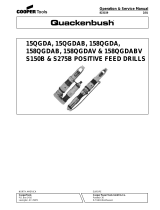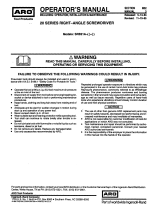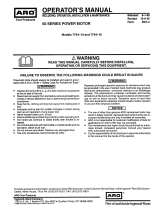Page is loading ...

16572644
Edition 2
June 2009
Save These Instructions
Air Drill
5 Series
Maintenance Information

2 16572644_ed2
WARNING
Always wear eye protection when operating or performing maintenance on this tool.
Always turn o the air supply and disconnect the air supply hose before installing, removing or adjusting any accessory on this tool or
before performing any maintenance on this tool.
Note: When reading the instructions, refer to exploded diagrams in parts Information Manuals when applicable (see under Related Documentation
for form numbers).
Lubrication
Each time a Series 5 Drill is disassembled for maintenance and repair
or replacement of parts, lubricate the tool as follows:
Inject a few drops of Ingersoll Rand No. 10 Oil into each vane slot
in the Rotor bore before inserting the Vanes.
Work enough Ingersoll Rand No. 23 Grease into the Front Rotor
Bearing (108) and Spindle Bearing (131) to coat the balls and
races; apply a heavy coat of the recommended grease into the
Rear Rotor Bearing (3 and 53) before installing the motor in the
Motor Housing.
1.
2.
Apply a coat of Ingersoll Rand No. 23 Grease to the Planet
Gears (125 and 132), the planet gear shafts, the bearing surfaces
on the Spindle (127) and Gear Head (124) and the teeth on the
Ring Gear (121).
NOTICE
Do not pack the gear chamber with grease; excessive grease will
cause a loss of power and overheating.
3.
Disassembly
General Instructions
Do not disassemble the tool any further than necessary to replace
or repair damaged parts.
Whenever grasping a tool or part in a vise, always use leather-
covered or copper-covered vise jaws to protect the surface of
the part and help prevent distortion. This is particularly true of
threaded members and housings.
Do not remove any part which is a press t in or on a subassembly
unless the removal of that part is necessary for repairs or
replacement.
Do not disassemble the tool unless you have a complete set of
new gaskets and O-rings for replacement.
Disassembly of the Gearing
Lightly clamp the Motor Housing (1 or 51) in a vise with the
spindle end up.
NOTICE
Take care not to distort the motor bore.
2. Remove the Spindle Bearing Locknut (133) from the Housing and
withdraw the gearing. Except for the moderate press t of the
Spindle Bearing (131) on the Spindle (127), all gearing parts are
free tting and will easily slide apart.
Disassembly of the Motor
NOTICE
All motor parts are free tting except for the Rear End Plate (102)
which is retained by the End Plate Retainer (103).
Withdraw the motor assembly from the Housing.
Remove Rear End Plate Gasket (111) from the Housing.
Remove End Plate Retainer and Rear End Plate (102).
Remove Bearing Retaining Washer (109), Front Rotor
Bearing (108), Front Rotor Bearing Housing (106), Cylinder
Dowel (110), Cylinder (104), Rotor (101) and Vanes (105).
1.
2.
3.
4.
1.
1.
2.
3.
4.
Disassembly of the Throttle Mechanism for Pistol Grip
Drills
Using a small punch, remove the Throttle Retaining Pin (60) from
the Motor Housing (51) and withdraw the throttle mechanism.
Remove the Throttle Valve Face (55) from the Throttle Valve (54).
Remove the Throttle Valve from the Throttle Bushing (56) and
remove the Throttle Bushing Seals (57).
For Reversible Models, remove the Throttle Valve Seat (58F),
Reverse Valve Bushing (58G) and Reverse Valve Seal Rings (58F).
NOTICE
If it is necessary to remove the Trigger (53B), a new Trigger must
be installed.
Disassembly of the Throttle Mechanism for Lever
Throttle Drills
Remove the Retainer Screw (14) and Throttle Assembly
Retainer (13) and withdraw the throttle mechanism.
NOTICE
Before proceeding, place an index mark on the Throttle Valve
Body (5) and Valve Knob (7) to assure their same relative position
when reassembling. It is possible to change the orientation 180°.
If this occurs, the Tool will not run.
2. Push the Valve Knob Retainer (9) from the Valve Knob (7) and
separate the Knob from the Throttle Valve Body being careful not
to lose the other throttle components.
3. Withdraw the Throttle Valve Seat (12) from the Valve Body.
1.
2.
3.
1.
Assembly
General Instructions
Always press on the inner ring of a ball-type bearing when
installing the bearing on a shaft.
Always press on the outer ring of a ball-type bearing when
pressing the bearing into a bearing recess.
Whenever grasping a tool or part in a vise, always use leather-
covered or copper-covered vise jaws. Take extra care with
threaded parts and housings.
Always clean every part and wipe every part with a thin lm of oil
before installation.
1.
2.
3.
4.
Apply a lm of O-ring lubricant to all O-rings before nal
assembly.
Check every bearing for roughness. If an open bearing must be
cleaned, wash it thoroughly in a clean, suitable, cleaning solution
and dry with a clean cloth. Sealed or shielded bearings should
never be cleaned. Work grease thoroughly into every open
bearing before installation.
Unless otherwise noted, always press on the stamped end of a
needle bearing when installing the needle bearing in a recess. Use
a bearing inserting tool similar to the one shown in Dwg. TPD786.
5.
6.
7.

16572644_ed2 3
Needle Bearing inserting Tool
Shoulder to
Regulate Depth
Pilot to t I.D. of Bearing.
Length of Pilot to be
approximately 1/8” less than
length of Bearing
15°
(Dwg. TPD786)
Assembly of the Throttle Mechanism for Lever
Throttle Drills
Insert the Throttle Valve (10) followed by the small diameter end
of the Throttle Valve Spring (11) into the Throttle Valve Body (5).
NOTICE
Make certain the Valve Knob Seal (8) is undamaged and in place
between the Knob and Valve Body.
2. Insert the Valve Knob (7) into the Throttle Valve Body and retain it
using the Valve Knob Retainer (9).
3. Examine the Throttle Valve Seals (6) and replace them if they are
worn or damaged. Apply a lm of O-ring lubricant to the O-rings
before assembly.
4. Insert the assembled throttle mechanism into the Motor Housing
and retain the mechanism using the Throttle Assembly
Retainer (13) and Retainer Screw (14).
Assembly of the Throttle Mechanism for Pistol
Grip Drill
NOTICE
If it becomes necessary to remove the Trigger (53B), a new
Trigger must be installed. The orientation of the Valve and
Trigger is important for maintaining optimum performance.
Install the Throttle Bushing Seat (58) in the Housing (51).
Install the Throttle Valve Face (55) in the groove in the Throttle
Valve (54) and apply a thin coat of O-ring lubricant.
Examine the Throttle Valve to identify a ground arc on the Valve
shaft near the Throttle Valve Face. Two unground at faces
connect with the arc.
Slide the Throttle Valve, barbed end rst, into the round end of the
Throttle Bushing Assembly (56) or Reverse Valve Assembly (58B)
and locate the drilled hole in the outside diameter of the Bushing.
View the Throttle Valve stem through the drilled hole. Rotate
the Throttle Valve until the ground arc lls the view through the
drilled hole. Maintain this relative positioning and stand the
partially assembled throttle on the workbench with the Throttle
Valve Face down.
Align the at on the top of the Trigger with the at on the top of
the Bushing, keeping the alignment as in Step 5 above, and press
the Trigger onto the exposed barbed end of the Valve. Recheck
the alignment of the Valve, Trigger and Bushing. When the parts
are properly positioned, the at on the Bushing and the at on
the top of the Trigger should align when the ground arc is seen
through the port in the side of the Bushing. Refer to Dwg. TPD602.
1.
1.
2.
3.
4.
5.
6.
Trigger
View the ground portion of the
throttle valve stem through here
Air port
Throttle
Bushing
Throttle
valve stem
Cross section through throttle valve
bushing and throttle valve showing
relative position of air port and valve stem
(Dwg. TPD602)
7. When inserting the assembled Throttle into the Motor Housing,
align the at on the Trigger with the at on the Bushing and
insert the assembly into the throttle hole with the ats closest to
the body of the Housing.
8. Retain the throttle mechanism in the Housing using the Throttle
Retaining Pin (60).
Assembly of the Motor
Slip the Rear End Plate (102) on the rear hub of the Rotor (101)
and install the Retainer (103) in the groove.
Hold the Rotor vertically and clamp the short hub in leather-
covered or copper-covered vise jaws.
Insert a Vane (105) in each slot.
Place the Cylinder (104), front end up, over the Rotor and onto
the Rear End Plate. To determine which end of the Cylinder is
the front end, hold the Cylinder horizontally, facing one end.
Position the external groove for the Dowel (110) at the top as
shown in the illustration. If the airports through the cylinder wall
are in the bottom right quadrant, you are facing the front of the
Cylinder. When assembling the motor, be sure to properly install
the Cylinder. The motor will not operate properly if the Cylinder
is inverted.
Slip the Front End Plate (106) over the rotor shaft. Press the Front
Rotor Bearing (105) into the Bearing Housing (107) with the
sealed face of the Bearing ush with one face of the Housing.
Slide the Bearing and Housing, sealed side rst, followed by the
Retaining Washer (109), onto the shaft.
Enter the Rear End Plate Gasket (111) into the Motor Housing
(1 or 51), positioning the Gasket smoothly on the backbore so
that the dowel notch in the Gasket aligns with the dowel hole in
the Housing.
Obtain a sti steel rod 3/32” (2.3 mm) diameter and approximately
10” (254 mm) long to use as an assembly dowel.
Align the dowel groove in the Rear End Plate, Cylinder and Front
End Plate with the dowel hole through the Rotor Bearing Housing
and insert the rod.
Enter the end of the assembly dowel in the dowel hole and slide
the motor assembly into the Housing. This is a sliding t and if
proper alignment is maintained, the assembly will enter under
only slight nger pressure. Do not drive or otherwise force the
motor into position.
Replace the assembly dowel with the Cylinder Dowel.
1.
2.
3.
4.
5.
6.
7.
8.
9.
10.

4 16572644_ed2
NOTICE
Make sure the Cylinder Dowel is entered into and remains
in the dowel hole in the Housing. When in proper position,
approximately 3/32” (2.3 mm) of the Dowel protrudes from
the face of the Bearing Housing. If it is not in the hole, it will
protrude approximately 7/32” (5.5 mm).
Assembly of the Gearing
Work the Slinger Ring (128), large end rst, over the Spindle shaft
and against the Gear Frame race. Follow with the Seal (129) and
the Grease Shield (130).
Install the Spindle Bearing (131) over the Spindle shaft. Firmly
support the Spindle (127) and press, do not drive, the Bearing
into position using an arbor that will contact only the inner ring
of the Bearing.
Slide the Ring Gear (121) into the Motor Housing (1 or 51), making
sure the Cylinder Dowel (110) enters one of the notches in the
end of the Gear. Check this engagement by trying to rotate the
Gear by hand.
For H, J or N ratio, slide the Rotor Pinion Spacer (122) followed by
the Rotor Pinion (123) onto the spline shaft on the Rotor (101).
For N ratio, slide a Gear Head Planet Gear (125) (13 teeth) onto
each of the three gear shafts on the Gear Head (124). Enter the
assembly into the Ring Gear (121) and slide it into engagement
with the Rotor Pinion. Slip the Gear Head Spacer (126) over the
spline on the Gear Head.
1.
2.
3.
4.
5.
NOTICE
For N ratio, a Gear Head Planet Gear (125) has 13 teeth and a
Spindle Planet Gear (132) has 14 teeth. Do not mix, mismatch
or switch locations with these small gears when reassembling
a tool.
6. For H, J, K, L or N ratio, slide a Spindle Planet Gear onto each of
the three gear shafts on the Spindle (127) and slide the assembly
into the Ring Gear and into engagement with the Rotor Pinion or
Gear Head.
7. Clean the threads on the Spindle Bearing Locknut (133) and
Motor Housing (1 or 51) to remove all grease and oil.
8. Apply lm of Vibra-Tite®** VC3 to the threads of the Motor
Housing (1 or 51).
9. With the Locknut hand tight, connect the air hose to the Inlet (18
or 66) and operate the Drill to check for smooth operation.
10. Clamp the Tool in a vise, taking care not to damage the Housing
and tighten the Locknut a minimum torque of 25 ft-lb (33 Nm).
11. Install Drill Chuck Spacer (134) on Spindle.
12. Thread Drill Chuck onto Spindle and tighten.
Troubleshooting Guide
Trouble Probable Cause Solution
Loss of Power Low air pressure Check air supply. For top performance, the air pressure must be
90 psig (6.2 bar/620 kPa) at the inlet.
Plugged Air Strainer Screen or Inlet Screen Clean the Air Strainer or Inlet Screen in a clean, suitable,
cleaning solution. If the Screen cannot be cleaned, replace it.
Clogged Muer or Exhaust Silencer Clean the Muer Element in a clean, suitable, cleaning
solution. If it cannot be cleaned, replace it.
Worn or broken Vanes Replace the complete set of Vanes.
Damaged Rear End Plate Gasket Install a new Rear End Plate Gasket.
Worn or broken Cylinder Replace the Cylinder if it is cracked or if the bore appears wavy
or scored.
Improper lubrication or dirt build-up Clean the Motor Unit parts and lubricate as instructed.
Leaky Throttle Valve Worn Throttle Valve and/or Throttle Valve Seat Install a new Throttle Valve and/or a Throttle
Valve Seat.
Dirt accumulation on Throttle Valve and/or
Throttle Valve Seat
Pour about 3 cc of a clean, suitable, cleaning solution in the
air inlet and operate the tool Valve for about 30 seconds.
Immediately pour 3 cc of the recommended oil in the air inlet
and operate the tool for 30 seconds to lubricate all the cleaned
parts.
Gear Case gets hot Excessive grease Clean and inspect the Gear Case and gearing parts and
lubricate as instructed.
Worn or damaged parts Clean and inspect the Gear Case and gearing. Replace worn or
broken components.
Related Documentation
For additional information refer to:
Product Safety Information Manual 04580353.
Product Information Manual 16572166.
Parts Information Manual 16572786.
Manuals can be downloaded from www.ingersollrandproducts.com
** Registered trademark of ND industries

Notes:

Notes:

Notes:

www.ingersollrandproducts.com
© 2009 Ingersoll Rand Company
/



